
Monday, January 9, 2012
Thursday, October 27, 2011
Etsy Vegan MoFo Fun!
On Etsy, my shop (Knightime Creations) is a member of the Vegan Etsy Team. I am honored to be a part of such an awesome group of creative vegans. To celebrate this, I've made a treasury of Vegan Etsy items for today's post. (I also think I gained 10 pounds just putting it together!)
Thursday, October 20, 2011
Tuesday, August 23, 2011
Tuesday, July 12, 2011
My 16th Century Flemish Working Woman's Dress
Mark and I are contracted to play at faires that have Medieval themes and others that have Renaissance themes (usually Tudor), and these faires take place throughout the year, so it can actually be blazing hot and freezing cold during the run of a single faire. (Kansas City Ren Faire, I'm looking at you!) I made a couple of 14th century fitted kirtles to cover the Medieval side of things, but I also wanted an outfit that would both fit in with a Renaissance theme and work in colder weather. Enter the 16th century Flemish dress, which has an under-dress (kirtle), an overgown, tie-on (or pin-on) sleeves, and a partlet (or two!) This outfit is both versatile and attractive (and so much more comfortable and authentic than my too-small Moresca bodice!)
I was greatly inspired by Jen Thompson's Flemish dress, as well as her inspiration, Drea Leed's Flemish dress. Drea has some really great information about how to construct a Flemish outfit as well. My mother is also very good at sewing (and she has a much more reliable sewing machine than I, as well as a serger), so I asked her if she would help me make my Flemish outfit. However, though my mother is a good seamstress, she isn't very adventurous, and decided there was no way she could possibly draft a pattern - she'd much rather sew from an existing pattern instead. Since she had graciously agreed to help me with this endeavor, I reluctantly decided to purchase a pattern rather than use Drea Leed's corset pattern generator, bodice pattern instructions, and gathered kirtle instructions. In the long run, I'm really wishing I hadn't, but hindsight is 20/20 (as we all know). In any case, I think my results were perfectly acceptable.
I started by looking through the patterns at Reconstructing History, and finally narrowed it down to either the Elizabethan Working Woman's Dress or the Netherlandish Woman's Dress. Unfortunately, the front covers of the patterns have not-so-great drawings of historical paintings as opposed to drawings of the dress that will be produced from the actual pattern being sold (or even better, a photo of someone wearing the dress made from the actual pattern!), and I couldn't quite tell which pattern would be more likely to produce an outfit like Jen Thompson's. I contacted Kass at Reconstructing History, and she told me that Jen's outfit was much more English than Flemish (???), and I'd probably be better off getting the Elizabethan Common Woman's Dress. Now, I don't know what the pattern pieces look like in the Netherlandish pattern, but the Elizabethan pattern has an overgown that closes completely up the front (even though one of the drawings on the front shows an overgown that's open several inches from top to bottom) and a partlet that is much simpler, smaller, and doesn't tie under the arms. My mother, my boyfriend Mark, and I started making a mock-up for the bodice piece, using the RH pattern.

Like a few other patterns I've seen, the top edge of the center front curves up. I have no idea what sort of body shape this bodice is meant to fit, but mine isn't it. The upwards curve produced a top edge that stood out away from my bust, and didn't do anything other than look silly. The bodice also seemed a bit short - I'm somewhat pear-shaped, so a waist seam that's too high will make me look like a triangle. We went back to the pattern and lengthened the bottom edge/waistline, brought the front down into a bit lower point, and folded the top edge (neckline) of the front piece down so that it went straight across instead of curving up.

Meanwhile, we were also making a couple of smocks out of 3.5 oz handkerchief-weight white linen from Fabrics-store.com . I used Simplicity 2621 for these (and I'm thinking that the drafter borrowed heavily from Drea Leed's Elizabethan Smock Pattern Generator). This is not the first time I've made the smock pattern, so I've figured out pretty much how to made it work. I've been using the size 10 pieces for the body of the smock and the size 16 sleeve pieces. It produces a smock that's fairly fitted through the bust and flares out a bit from there. I also decreased the amount of tapering that the sleeves do, in order to have fuller sleeves that can be rolled up.
. I used Simplicity 2621 for these (and I'm thinking that the drafter borrowed heavily from Drea Leed's Elizabethan Smock Pattern Generator). This is not the first time I've made the smock pattern, so I've figured out pretty much how to made it work. I've been using the size 10 pieces for the body of the smock and the size 16 sleeve pieces. It produces a smock that's fairly fitted through the bust and flares out a bit from there. I also decreased the amount of tapering that the sleeves do, in order to have fuller sleeves that can be rolled up.
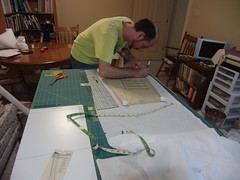
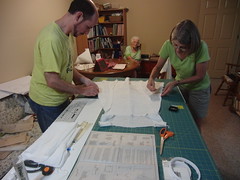
Here's the pieces (minus the sleeves) for an Elizabethan smock. Notice anything wrong? Yup, the back piece is considerably shorter than the front piece. This is what happens when one has been working all day on various items of clothing and has not taken account of the "fold here for shorter smock" notation on the pattern piece one traced. Oops. The longer piece is correct, so we ended up sewing a piece onto the back to make them the same length.
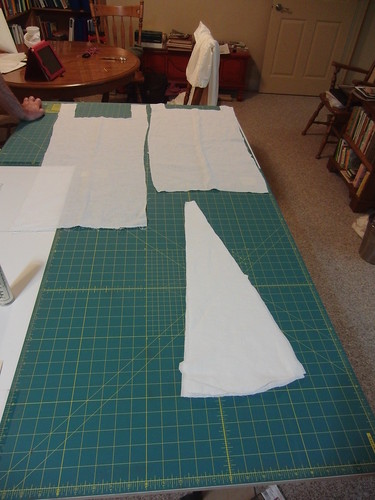
The RH pattern instructions are rather sketchy in places, telling the sewer various ways things were done in period, but not always giving detailed directions for each step. Several things were left up to the sewer to decide how to do them, and other things needed to be modified or disregarded completely in order to make the pattern do what I wanted it to do. For the skirt pleats (in both the kirtle and overgown), I chose to make double box pleats, since I wanted the skirt to poof out as much as possible and also because the '"5 inches of fabric = 1 inch of pleating" meant that my 2 back skirt panels would condense almost perfectly to the bodice back waist measurement.
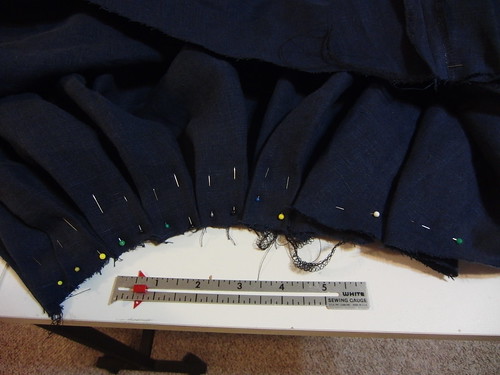
Here's the Flemish kirtle from the back. Ignore the disarray of the skirt (Mark didn't think to arrange it, so it's falling funny) and the wrinkles (this picture was taken on the 4th or 5th day of SCA Lilies War, and it's not the first time I'd worn the kirtle while I was there).
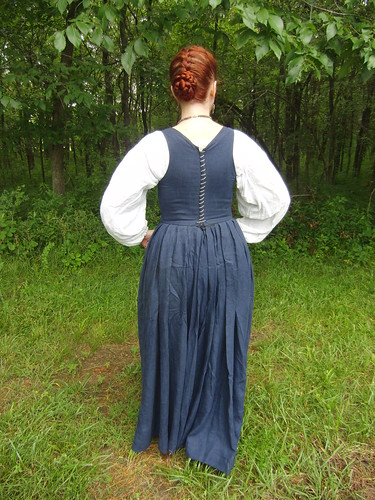
Here's the Flemish kirtle from the front. I'm not happy with the way it wrinkles under the bust, but it's too late now to sew boning between the outer and inner layers of fabric, so I think I'm just going to sew several strips of boning to the inside of the inner layer and just try to make the stitches as invisible as possible. I did use boning at the side seams, which helps some.
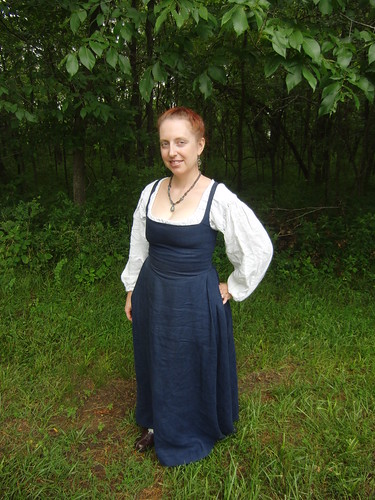
Remember the pattern discrepancies I mentioned earlier? They continued to the overgown as well. The side seam of the overgown front piece is 2/8" or 3/8" longer than the side seam of the overgown back piece, the armholes are very oddly shaped and don't lie flat against the body (mine, anyway), and one side of the skirt pattern piece is an inch shorter than the other side. We were too busy making new pattern pieces and pinning (and re-pinning) mockups to get pictures of this stage.
The overgown pattern piece in the Elizabethan Commonwomen's Outfit from Reconstructing History laces completely closed in the front, so I had to make several mockups to get the correct opening at the front for my Flemish dress. Looking at this makes me think I could have just used one of the vest patterns my mother was so fond of making 10 years ago! *laugh*
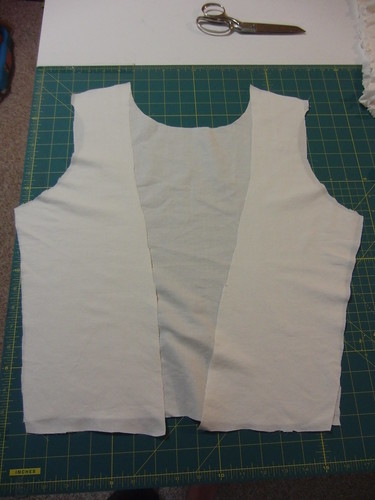
Here's the best mockup laced over my kirtle. It's puckering a bit more than I'd like, but it'll do. I'm using purple ribbon to lace it up because it's the best we had (we later bought some nice gold grosgrain ribbon).
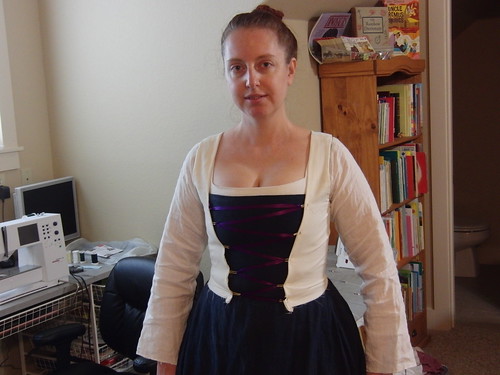
I wasn't quite sure how I wanted to lace the overgown at first. I'd considered metal rings, but decided to use blue cord since I had originally wanted the overgown to be reversible, and cord could be sewed between the inner and outer layers of the bodice easily by machine. Also, the blue cord pretty much disappears against the blue of the kirtle, which is nice.
Here are the loops tacked onto the outer bodice layer, which is ready to be sewn to the lining and then turned right side out (which will then make the loops stick out instead of in).
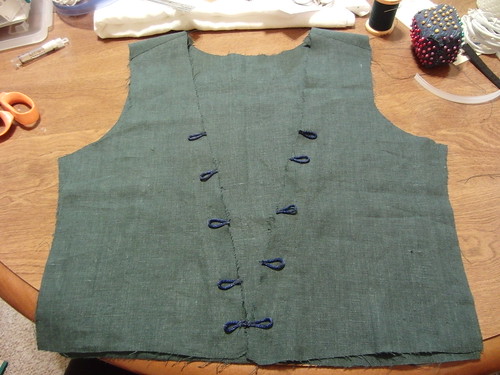
Here's the finished Flemish gown! I chose to make the sleeves tie-on instead of pin-on, since I really liked the way the ribbons look. The sleeves are reversible - green on one side (to match the overgown) and blue on the other (to match the kirtle). I chose to make the overgown not be open the whole way down, since I really liked the way Jen Thompson's version looked. Pardon the lack of a partlet - I've still got to draft a pattern for it and make it, though that should happen very soon (I want to have it ready by Pennsic).



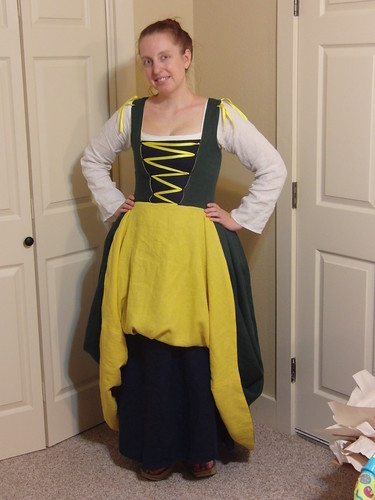
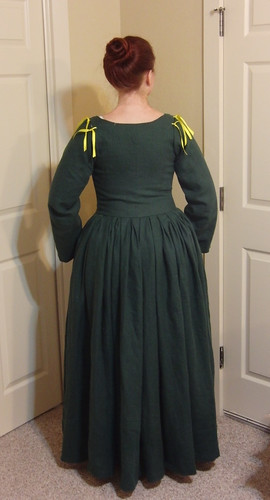
Here's my Flemish dress from the side. Jen Thompson discusses the possibility of wearing a bumroll with her dress as a means to give the very full back seen in some period paintings. I found that 3 layers of double box pleats (the overgown lining was pleated inwards instead of outwards) produces a very satisfactory poof. I'm hoping it will still look like this after a full season of washing and wear.
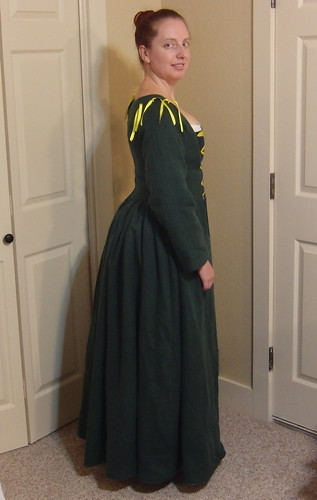
Unlike the pattern for my dress, the pattern for Mark's tunic was decent (Reconstructing History's 12th-16th Century Peasant Man). The only thing we had to fix were the sleeves, which were both too long and too tapered. The good thing was that by shortening the sleeves, we also fixed the tapering problem.
Here my mother models Mark's tunic. She's a little bit shorter than he. *grin*
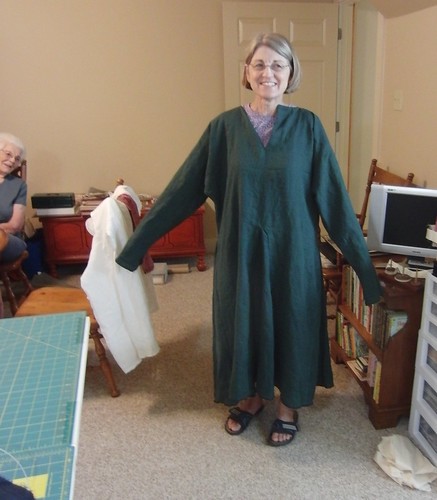
I should mention that I'm aware that my choice of color combination may not be completely period-accurate, but Mark and I have been using blue, green, and gold as the more-or-less official colors of our band (the Tulstin Troubadours). I designed our outfits to use those colors and coordinate so as to be a band uniform of sorts. His green tunic will also have blue linen stockings, and we're both going to have blue hoods lined with gold (mine will be a liripipe hood to go with my 14th century fitted kirtles). All of our garb uses 5.3 oz. mid-weight (IL019) cobalt blue, emerald green, and mustard yellow linen from Fabrics-store.com . My smocks are 3.5 oz handkerchief-weight (IL020) bleached white linen, as will my partlet be once I make it. The black partlet will be made from 7.1 oz heavy-weight (4C22) black softened linen (I'm going for as much warmth as I can get - I might possibly use the linen as lining and do the outer fabric in black velvet if I can find some for cheap.)
. My smocks are 3.5 oz handkerchief-weight (IL020) bleached white linen, as will my partlet be once I make it. The black partlet will be made from 7.1 oz heavy-weight (4C22) black softened linen (I'm going for as much warmth as I can get - I might possibly use the linen as lining and do the outer fabric in black velvet if I can find some for cheap.)
I was greatly inspired by Jen Thompson's Flemish dress, as well as her inspiration, Drea Leed's Flemish dress. Drea has some really great information about how to construct a Flemish outfit as well. My mother is also very good at sewing (and she has a much more reliable sewing machine than I, as well as a serger), so I asked her if she would help me make my Flemish outfit. However, though my mother is a good seamstress, she isn't very adventurous, and decided there was no way she could possibly draft a pattern - she'd much rather sew from an existing pattern instead. Since she had graciously agreed to help me with this endeavor, I reluctantly decided to purchase a pattern rather than use Drea Leed's corset pattern generator, bodice pattern instructions, and gathered kirtle instructions. In the long run, I'm really wishing I hadn't, but hindsight is 20/20 (as we all know). In any case, I think my results were perfectly acceptable.
I started by looking through the patterns at Reconstructing History, and finally narrowed it down to either the Elizabethan Working Woman's Dress or the Netherlandish Woman's Dress. Unfortunately, the front covers of the patterns have not-so-great drawings of historical paintings as opposed to drawings of the dress that will be produced from the actual pattern being sold (or even better, a photo of someone wearing the dress made from the actual pattern!), and I couldn't quite tell which pattern would be more likely to produce an outfit like Jen Thompson's. I contacted Kass at Reconstructing History, and she told me that Jen's outfit was much more English than Flemish (???), and I'd probably be better off getting the Elizabethan Common Woman's Dress. Now, I don't know what the pattern pieces look like in the Netherlandish pattern, but the Elizabethan pattern has an overgown that closes completely up the front (even though one of the drawings on the front shows an overgown that's open several inches from top to bottom) and a partlet that is much simpler, smaller, and doesn't tie under the arms. My mother, my boyfriend Mark, and I started making a mock-up for the bodice piece, using the RH pattern.

Like a few other patterns I've seen, the top edge of the center front curves up. I have no idea what sort of body shape this bodice is meant to fit, but mine isn't it. The upwards curve produced a top edge that stood out away from my bust, and didn't do anything other than look silly. The bodice also seemed a bit short - I'm somewhat pear-shaped, so a waist seam that's too high will make me look like a triangle. We went back to the pattern and lengthened the bottom edge/waistline, brought the front down into a bit lower point, and folded the top edge (neckline) of the front piece down so that it went straight across instead of curving up.

Meanwhile, we were also making a couple of smocks out of 3.5 oz handkerchief-weight white linen from Fabrics-store.com


Here's the pieces (minus the sleeves) for an Elizabethan smock. Notice anything wrong? Yup, the back piece is considerably shorter than the front piece. This is what happens when one has been working all day on various items of clothing and has not taken account of the "fold here for shorter smock" notation on the pattern piece one traced. Oops. The longer piece is correct, so we ended up sewing a piece onto the back to make them the same length.

The RH pattern instructions are rather sketchy in places, telling the sewer various ways things were done in period, but not always giving detailed directions for each step. Several things were left up to the sewer to decide how to do them, and other things needed to be modified or disregarded completely in order to make the pattern do what I wanted it to do. For the skirt pleats (in both the kirtle and overgown), I chose to make double box pleats, since I wanted the skirt to poof out as much as possible and also because the '"5 inches of fabric = 1 inch of pleating" meant that my 2 back skirt panels would condense almost perfectly to the bodice back waist measurement.

Here's the Flemish kirtle from the back. Ignore the disarray of the skirt (Mark didn't think to arrange it, so it's falling funny) and the wrinkles (this picture was taken on the 4th or 5th day of SCA Lilies War, and it's not the first time I'd worn the kirtle while I was there).

Here's the Flemish kirtle from the front. I'm not happy with the way it wrinkles under the bust, but it's too late now to sew boning between the outer and inner layers of fabric, so I think I'm just going to sew several strips of boning to the inside of the inner layer and just try to make the stitches as invisible as possible. I did use boning at the side seams, which helps some.

Remember the pattern discrepancies I mentioned earlier? They continued to the overgown as well. The side seam of the overgown front piece is 2/8" or 3/8" longer than the side seam of the overgown back piece, the armholes are very oddly shaped and don't lie flat against the body (mine, anyway), and one side of the skirt pattern piece is an inch shorter than the other side. We were too busy making new pattern pieces and pinning (and re-pinning) mockups to get pictures of this stage.
The overgown pattern piece in the Elizabethan Commonwomen's Outfit from Reconstructing History laces completely closed in the front, so I had to make several mockups to get the correct opening at the front for my Flemish dress. Looking at this makes me think I could have just used one of the vest patterns my mother was so fond of making 10 years ago! *laugh*

Here's the best mockup laced over my kirtle. It's puckering a bit more than I'd like, but it'll do. I'm using purple ribbon to lace it up because it's the best we had (we later bought some nice gold grosgrain ribbon).

I wasn't quite sure how I wanted to lace the overgown at first. I'd considered metal rings, but decided to use blue cord since I had originally wanted the overgown to be reversible, and cord could be sewed between the inner and outer layers of the bodice easily by machine. Also, the blue cord pretty much disappears against the blue of the kirtle, which is nice.
Here are the loops tacked onto the outer bodice layer, which is ready to be sewn to the lining and then turned right side out (which will then make the loops stick out instead of in).

Here's the finished Flemish gown! I chose to make the sleeves tie-on instead of pin-on, since I really liked the way the ribbons look. The sleeves are reversible - green on one side (to match the overgown) and blue on the other (to match the kirtle). I chose to make the overgown not be open the whole way down, since I really liked the way Jen Thompson's version looked. Pardon the lack of a partlet - I've still got to draft a pattern for it and make it, though that should happen very soon (I want to have it ready by Pennsic).





Here's my Flemish dress from the side. Jen Thompson discusses the possibility of wearing a bumroll with her dress as a means to give the very full back seen in some period paintings. I found that 3 layers of double box pleats (the overgown lining was pleated inwards instead of outwards) produces a very satisfactory poof. I'm hoping it will still look like this after a full season of washing and wear.

Unlike the pattern for my dress, the pattern for Mark's tunic was decent (Reconstructing History's 12th-16th Century Peasant Man). The only thing we had to fix were the sleeves, which were both too long and too tapered. The good thing was that by shortening the sleeves, we also fixed the tapering problem.
Here my mother models Mark's tunic. She's a little bit shorter than he. *grin*

I should mention that I'm aware that my choice of color combination may not be completely period-accurate, but Mark and I have been using blue, green, and gold as the more-or-less official colors of our band (the Tulstin Troubadours). I designed our outfits to use those colors and coordinate so as to be a band uniform of sorts. His green tunic will also have blue linen stockings, and we're both going to have blue hoods lined with gold (mine will be a liripipe hood to go with my 14th century fitted kirtles). All of our garb uses 5.3 oz. mid-weight (IL019) cobalt blue, emerald green, and mustard yellow linen from Fabrics-store.com
Saturday, July 2, 2011
Fantasy Artists of Etsy Exhibition - Return to Renaissance
Monday, January 24, 2011
Brrrr....
It's so cold outside, I decided to make a nice warm sunny treasury to make everyone feel better!
A Bright Sunshiny Day
A Bright Sunshiny Day
Subscribe to:
Posts (Atom)



